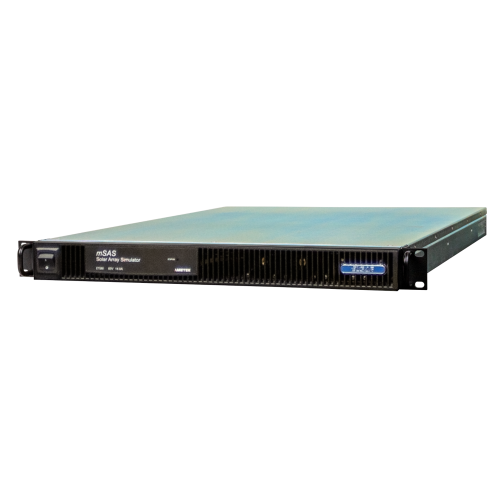Elgar mini-Solar Array Simulator (m-SAS)
The Elgar mini-Solar Array Simulator is designed for testing satellites' photovoltaic arrays in space conditions. With an 840W power supply, it replicates solar array dynamics accurately under various environmental factors. It features high-resolution IV curve simulation, rapid Maximum Power Point Tracking (MPPT), low output capacitance, and active power factor correction.
Satellites and spacecraft orbiting Earth and distant planets like Jupiter rely heavily on photovoltaic arrays to harness solar energy for power. These arrays, composed of multiple solar cells, face varying environmental conditions such as temperature fluctuations and changes in solar irradiance, impacting their performance. Ensuring these solar arrays operate reliably over years of space missions requires rigorous ground testing using specialised equipment like the Elgar mini-Solar Array Simulator (m-SAS).
Key Features and Benefits:
Designed specifically for small satellite applications, the Elgar mini-Solar Array Simulator offers advanced capabilities to replicate the dynamic electrical behaviour of a photovoltaic array under simulated space conditions. Here’s why it stands out:
- High-Resolution IV Curve Simulation: The m-SAS excels in accurately reproducing both static and dynamic current-voltage (I-V) characteristics of solar arrays. This capability is crucial for testing and optimising Maximum Power Point Tracking (MPPT) algorithms used in modern small satellites, ensuring efficient power conversion even under varying environmental conditions.
- Rapid Maximum Power Point Tracking (MPPT): With a high-speed MPPT tracking capability of up to 250Hz, the m-SAS swiftly adjusts to changes in solar irradiance, mimicking real-time responses of solar arrays in orbit. This feature is essential for validating the performance and reliability of satellite power systems.
- Low Output Capacitance and Active Power Factor Correction (PFC): Engineered with low output capacitance, the m-SAS minimises transient effects and ensures accurate simulation of electrical responses. Active Power Factor Correction enhances efficiency and stability, contributing to precise and consistent testing results.
- Remote Control and Interface Flexibility: Equipped with a standard LAN interface, the m-SAS allows seamless integration into automated testing setups. It supports full remote control via AMETEK’s dedicated m-SAS software and SCPI commands over Ethernet, enabling operators to manage and monitor tests remotely with ease and precision.
- Eclipse Irradiance Profiles: The m-SAS includes sophisticated features for simulating eclipse scenarios with precise control over irradiance profiles. This capability allows for comprehensive testing under varying degrees of shadowing and illumination, replicating realistic operational conditions in space.
The Elgar mini-Solar Array Simulator represents a critical tool for ensuring the reliability and performance of satellite power systems through precise simulation of photovoltaic array behaviours. With its advanced capabilities and robust design, it meets the rigorous demands of small satellite testing, offering engineers and researchers the confidence to innovate and optimise spaceborne power solutions.
-
Environmental Specifications Operating Temperature 0° to +40° C (+32° to +104° F) Storage Temperature -25° to +65 °C (-13° to +149° F) Operating Humidity 20-95 %, non-condensing Storage Humidity 10-95 %, non-condensing Altitude 1500 m (5,000 ft), derate 10% of full power for every 1,000 feet higher Cooling Force-air inlet, rear exhaust. Temperature-controlled variable speed fans. Units may be stacked without spacing
-
Ideal for testing the electrical performance of small satellites, the Elgar™ mini-Solar Array Simulator supports the development and validation of satellite power systems equipped with advanced MPPT regulation topologies. It’s tailored for:
- Validating MPPT algorithms in varying environmental conditions.
- Replicating solar array behaviours during orbital operations.
- Testing under eclipse and other challenging scenarios.

